Narthaki

News

Info

Featured

 |
  |
Remembering photographer Dhiraj Chawda - Dr. Sunil Kothari e-mail: sunilkothari1933@gmail.com Photos courtesy: Savitri Ramaiah November 21, 2012  Dhiraj Chawda
When I started writing for The Illustrated Weekly of India in the early
sixties, I met the celebrated photographer Dhiraj Chawda, whose
photographs regularly appeared in the Times of India group of
publications. I saw many colour photographs of the renowned Manipuri
exponents, the Jhaveri Sisters. One of the photographs of Rasalila was
interesting, taken during dancers performing, with the result that it
looked blurred and one cannot see their faces. But the movement was
caught magically.
It was Nayana Jhaveri, the eldest among the four sisters, who introduced me to Dhiraj Chawda. I used to write for a Gujarati monthly Kumar, published form Ahmedabad. It had a great reputation. Anyone who got his/her article published in that magazine received recognition. So high were the standards of Kumar, that an entire generation of Gujarati poets, writers, and painters became well known. Gyanpith awardees, poets like Uma Shankar Joshi, Rajendra Shah were regular contributors to Kumar. So was a painter and poet Pradumna Tanna. Similarly, poet and painter Gulam Mohammed Sheikh used to have his poems published in Kumar. I came to know them from Kumar magazine. We all became lifelong friends. Dhiraj Chawda also used to read Kumar. Therefore, he had seen my articles on classical Indian dance. Thanks to Nayana Jhaveri's introduction, we started working together whenever he used to take photographs of dancers. I am talking of the 60s and 70s. I had started reviewing as a dance critic of The Evening News of India, an evening newspaper with my by-line Sunil Kothari and later on for The Times of India daily newspaper. In those decades, Mrinalini Sarabhai, Chandralekha, Kumudini Lakhia, Shanta Rao, Yamini Krishnamurty, to name a few leading dancers, were often featured in the Times of India publications. 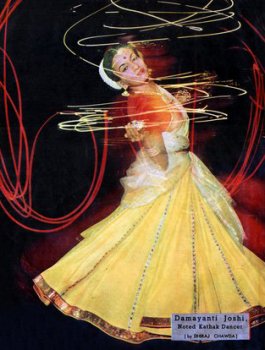 Kathak exponent Damayanti Joshi 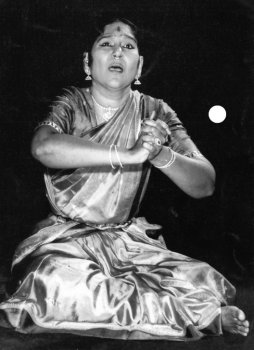 Balasaraswati One day Dhiraj bhai phoned me and asked me to join him at Indian Chambers of Commerce upstairs, near Churchgate. I was at that time teaching accounts at Sydenham College of Commerce and Economics, which was next door. Dhiraj bhai was to take photographs of Yamini Krishnamurty. I told Dhiraj bhai to take photos of Navasandhi, a rare item performed by dancers in Bharatanatyam. He took nine photos of Yamini. I wrote the captions for the Navasandhis, which were published in Femina with a brief biographical note on Yamini and also on Navasandhi dance. It drew the attention of Mr. Raman, the Editor of The Illustrated Weekly of India. He was a knowledgeable editor on Indian classical dance forms. With Dhiraj bhai, I met him in the office of The Times of India. Meanwhile Dr. Jhanghiani, the editor of Femina, also met me and suggested that I do a series of features on young dancers with brief biographical sketches and captions which would explain the dance poses and expressions the photographer had captured. Vimala Patil was then assistant editor of Femina. Thus started our jugalbandi and for more than ten years we did alternate week - as Femina was a fortnightly - a series on young, up and coming dancers who by now have become the leading lights of Indian dance world and some have become legends. In the process, I started learning a lot about photography and dancers were pleased to see correct poses and hastas, hand gestures and expressions. It inspired among dancers and photographer, confidence and also mutual respect. The dancer, the photographer and dance critic started making dance photographs with meaningful expressions. I started learning photography thanks to Dhiraj bhai. With Pentax and Rollifax cameras, I also started taking photographs. I owe it to Dhiraj bhai and another dear departed photographer friend, Subodh Chandra. 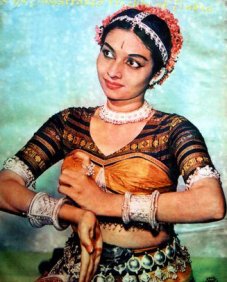 Yamini Krishnamurty for cover of The Illustrated Weekly  Padma Subrahmanyam Dhiraj bhai has taken several hundreds of photographs of dancers. I have with me published photographs of Jhaveri Sisters, Mrinalini Sarabhai, Chandralekha, Damayanti Joshi, Balasaraswati, Yamini Krishnamurty, Dr. Padma Subrahmanyam, Sonal Mansingh and others in my modest dance collection. Also, the issues of Femina in which they were featured. My mentor, Late Professor Mohan Khokar, had taught me to collect them. Dhiraj bhai had a special knack of putting dancers at ease. He would crack a joke and the tension would disappear. Also, we would tell dancers not to be self conscious and ignore us and not to worry about the technical problems we used to face. I would sometimes hold a white umbrella for lighting. Sometimes the angle would be incorrect from point of view of correct pose, hand gestures, and full frame. Therefore, we would have a few retakes. The glaring lights, costumes, air condition would not work every time, the heat, perspiration etc would bother the dancers and us also. However, the dancers used to put up with that. Dhiraj bhai - as the name suggested, Dhiraj meaning patience - had lot of patience. He also liked to see the dancers in the right and pleasant mood. Once, he made me hold an umbrella towards the black backdrop of a dancer and explained how the backlight lights up her hair and separates from the black background. Also, how the hair is lit up and no shadows are seen. Later on, I saw this technique used by many photographers. Many years later, late Gautam Rajadhyaksha who took photographs of film stars also explained how he had learnt this technique studying photographs of Dhiraj Chawda. One more technique he explained to me was how to take photographs as multiple exposure. The Navarasas of Chandralekha was published in The Illustrated Weekly of India. It clearly showed nine expressions in succession with multiple exposure technique. Once, before Mrinalini Sarabhai was to leave for South America, the Femina editor asked me to arrange a photo shoot at Dr. Vikram Sarabhai's residence at Napean Sea Road. Dhiraj bhai and I reached on time as planned. But Mallika Sarabhai had developed high fever, and was crying inconsolably as Mrinalini was leaving for a month long tour, leaving her behind. So till she stopped crying and fell asleep, we had to wait. Mrinalini was also distressed and was in no mood to have photos taken. We understood her plight. But being a sport, she got dressed and gave excellent photos, which made the cover of Femina, super imposed with hand gesture of fully blown lotus. It adorns Mrinalini Sarabhai's residence at Darpana. 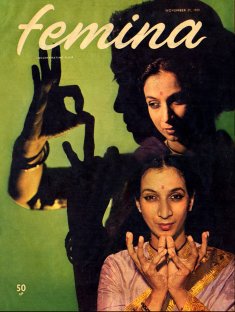 Mrinalini Sarabhai for cover of Femina 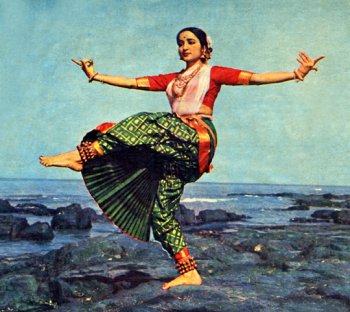 Chandralekha Dhiraj bhai never said no when I would plan a photo feature with dancers. He started enjoying the songs danced during performances and would listen to my running commentary of the dance. We built up a rapport over the years. I was conducting research on Odissi dance at Cuttack and Bhubaneswar in mid sixties staying with Babulal Doshi who had established Kala Vikash Kendra (the diamond jubilee of it is being celebrated this year in December). At my suggestion Babulal invited Dhiraj Chawda to visit Cuttack, Bhubaneswar and Konark to take photos for the archive of Kala Vikash Kendra. That was the most memorable tour of ours, visiting Cuttack, Bhubaneswar and Konark. For any photographer, Konark is irresistible. Dhiraj bhai was very excited. He took several photos which are excellent. On our visit to Puri, we met the legendary film director Satyajit Ray, who knew Dhiraj Chawda. Dhiraj bhai requested to take his photos on Puri beach in the early morning. There was soft early morning light. But Satyajit Ray had to leave for Gopalpur-on-sea, where he used to write his scripts. So Dhiraj bhai asked me to walk on the beach and took my photos in that morning light. I was real lucky. We went to Jagannath temple and met Guru Pankaj Charan Das. We wanted to take photos of Gotipua dancers performing on a boat, during the Chandan Jatra festival. So Guruji hired another boat for us to follow and take photos from there. These were the most memorable photos of Chandan Jatra, and rare historically, as after few years, the festival discontinued and those photos were the last ones of the festival. The photograph of Gotipua dancers performing before the temple appeared on the cover of The Illustrated Weekly of India. The Gotipua dancer Rabi Narayan Panda has framed the cover and it hangs on the wall of his modest residence. Neither Dhiraj Chawda nor I realized that we were documenting history of Odissi dance. In the mid sixties the travelling conditions, hotel accommodations were not comfortable. But never once did Dhiraj bhai complain. Fame had not gone to his head. He remained humble. He had branched off into glamour photography of film stars and majority of them admired his work and ability to take photos with superb lighting. Of course he was in great demand as a freelancer. His contemporaries were Jitendra Arya, Balakrishna of The Illustrated Weekly of India, photographers Subodh Chandra, Ashvin Mehta and up and coming Avinash Pasricha who has made a name for specializing in dance photography. He admired Dhiraj Chawda and his art. Avinash wanted to get his colour transparencies of Indrani Rahman he had taken for SPAN Magazine, corrected when they had turned green. Recalling and paying tributes to Dhiraj Chawda, Avinash Pasricha says: “Dhiraj Chawda was a great inspiration in my younger days when I had just joined SPAN as Photo Editor in 1960. Chawda's photos used to adorn many a cover of the only picture magazine in the country, The Illustrated Weekly of India. In fact, my first dance assignment for SPAN was Indrani Rahman. And I took a lot of pictures of her in Sapru House. But most of my transparencies turned out green in the processing - the black & white were okay. So, I had to ask Dhiraj for his picture of Indrani, which made a good cover for SPAN. I saw a few of his shows when he came to Delhi. We will miss him.” In my long career as a scholar, author, writer and a critic, I have met many photographers and have worked with them. I remember Dhiraj bhai fondly as I learnt a lot from him in terms of why photography documents moments, artistic angles, framing, right exposure, lighting, and pictures to look lively. Also in those years how to develop negatives, make prints, number them, keep them properly year wise and preserve them. Today, with digital technology, when even children click photos and the state of art technology has developed in leaps and bounds, the years during which Dhiraj bhai was taking photos and creating opportunities for next generation, one realizes what a noteworthy contribution he has made. He had a busy, lucrative career. Later on, he moved to Bangalore and worked from there. We used to occasionally correspond and had remained in touch, thanks to Bharatanatyam exponent Savitri Ramaiah. Savitri Ramaiah wrote to me informing about Dhiraj Chawda's passing away: “Dhiraj Chawda's first commercial photograph was published in Illustrated weekly in 1955. In 1957, his montage (multiple exposures in one negative) gave him his first fame as no one had used that technique before him. Even though he has published photographs in almost all major magazines and periodicals, he had not published any book. In 2007, a few friends got together to publish a coffee table book ‘Reflections over the last 50 years,' which was published by his brother, Manubhai Chawda. The book was released on December 22, 2007 at Prithvi Theatre, Mumbai, by Asha Parekh. It was a challenge to restore some of his old negatives and photographs for the coffee table book. His joy of photography ended with giving copies of his work to the clients. He did not preserve his negatives, nor did he think of marketing his photographs commercially at a later stage. He began taking photographs of dancers in 1958. His most famous work in the early years of his career was the Illustrated Weekly cover that featured all famous dancers of that time - Bala, Kamala Laxman, Yamini Krishnamurthy, Roshan Kumari, Birju Maharaj, and a Kathakali exponent. Unlike many professional photographers, Dhiraj Kaka did not consider photography from the business angle - I have known him to do a lot of assignments free of cost, and in case an artist paid him for a session, he also gave away the negatives, something many photographers did not do. Whenever I have asked him why he did not plan the business side of photography, his constant answer would be: ‘If my photography gave joy to the subject and his/her loved ones, what more do I need? Is there any wealth greater than the smile I see on people's face when they see their good photographs?' This is a rare thing, as no photographer generally parts with negatives. Dhiraj Chawda was an exception.” Dhiraj bhai and I had planned to do books on dance together, but we could not as he moved to Bangalore and I to Kolkata. Savitri Ramaiah used to keep me informed about him. A couple of times, we had planned to have his slide show at India International Centre in New Delhi, but I was abroad and it did not work out. Savitri informed me about his demise a few days ago and very kindly sent some images. Dhiraj Chawda is survived by his niece and brothers who live in Mumbai. Dhiraj bhai's wife had passed away earlier. They had no issue. He passed away peacefully on November 6, 2012 in Mumbai at the ripe age of 93. I always wonder why we do not have an archive of photographers, whose work could be seen by the new generation. I am sure there must be such an archive in India. I have suggested to Savitri to have Dhiraj Chawda's photo collection to be donated there in his memory. May his soul rest in peace.  Dr. Sunil Kothari is dance historian, scholar, author and a renowned dance critic. He is Vice President of World Dance Alliance Asia Pacific India chapter, based in New Delhi. He is honored by the President of India with Padma Shri, Sangeet Natak Akademi award and Senior Critic Award from Dance Critics Association, NYC. He is a regular contributor to www.narthaki.com, the roving critic for monthly magazine Sruti and is a contributing editor of Nartanam for the past 11 years. Post your comments Please provide your name and email id along with your comment. All appropriate comments posted with name and email id in the blog will also be featured in the site. |